文博信息
缅甸历史文化遗产震后速报 | 因瓦古城雷提大佛寺
摘要: 缅甸历史文化遗产震后速报 | 因瓦古城雷提大佛寺原创AAHM亚洲遗产管理学会2025年04月08日 21:31江苏Express News缅甸历史文化遗产震后速报引言 | Foreword2025年3月28日发生的7.9级强震致使缅甸遭遇重大损失,据中国新闻网和新京报最新通报,截至4月8日,缅甸28日发生的强震已造成3600人遇难,另有5017人受伤,约160人失踪,我们向所有遇难者致以沉痛的哀 ...
缅甸历史文化遗产震后速报 | 因瓦古城雷提大佛寺原创 AAHM 亚洲遗产管理学会 2025年04月08日 21:31 江苏
Express News
缅甸历史文化遗产震后速报
引言 | Foreword
2025年3月28日发生的7.9级强震致使缅甸遭遇重大损失,据中国新闻网和新京报最新通报,截至4月8日,缅甸28日发生的强震已造成3600人遇难,另有5017人受伤,约160人失踪,我们向所有遇难者致以沉痛的哀悼。地震也对缅甸曼德勒-实皆-内比都沿线众多的文化遗产造成了毁灭性打击,约670座寺庙损毁、290座佛塔倾覆,曼德勒皇宫、马哈牟尼佛寺、梅努寺、阿瓦大桥等重要建筑损毁严重或变为废墟。数百座佛塔、寺庙坍塌,人类共同文化遗产存续正面临严峻考验。
为此,亚洲遗产管理学会特发布系列“缅甸历史文化遗产震后速报”,呼吁全球社会关注缅甸历史文化遗产的珍贵价值及震后损毁情况,共同守护人类文明的瑰宝。
06
雷提大佛寺震后速报
Post-earthquake Express News of
Lay Htat Gyi Temple
“
01 遗产概况
雷提大佛寺坐落于缅甸因瓦古城南部,地理位置坐标为北纬21°50'24.6"、东经95°58'39.2",是阿玛拉普拉时期(Amarapura Era, 16世纪末至17世纪初)的重要佛教建筑遗存。寺院平面呈正方形布局,边长与高度分别达200英尺(约61米)和90英尺(约27.4米),原为四层木构建筑,后经砖石重建,保留了独特的方形多层形制。其历史可追溯至1597-1599年,由第二因瓦王朝的良渊王(Nyaung Yan)捐建,后由其子摩诃达玛亚扎王(Maha Da Ma Yarzar)续建完成。寺院在1766年中缅战争中毁于战火,1835年由贡榜王朝巴基道王(Bagyidaw)主持重建为砖石结构,次年又因地震受损,经后世修复得以保存至今,成为缅甸王朝更迭与建筑技术演变的见证者。
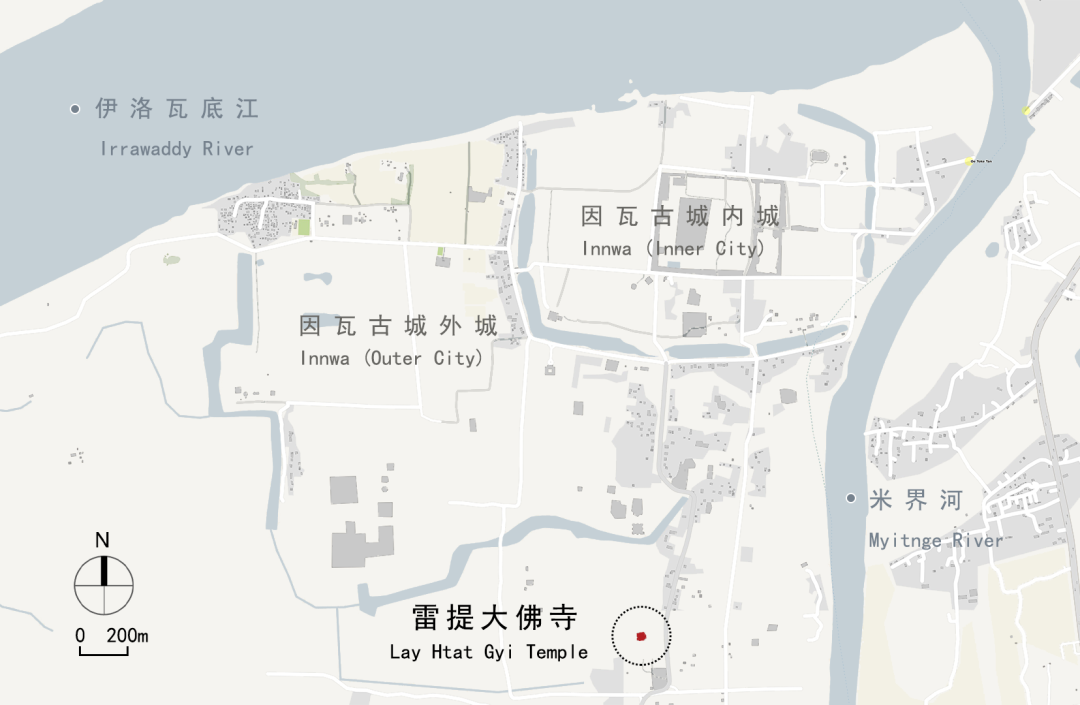
图1 雷提大佛寺区位示意图(来源:东南大学团队自绘)
Figure 1. Location of Lay Htat Gyi Temple (Source: Southeast University)
“
02 文化特色
雷提大佛寺的文化价值集中体现于其建筑艺术与宗教象征的深度融合。作为缅甸较少见的方形四层佛寺,其名称“Lay”(缅语“四”)呼应了原建筑的四层结构。寺院装饰细节丰富,露台饰以繁复的花卉灰泥浮雕,四角矗立缅甸神话中的食人魔像(Beeloo),每层转角处设立小型佛塔强化了佛教象征体系。四面入口的花卉三角楣饰以须弥山为意象,暗合佛教教义宇宙观,四面通达的阶梯设计隐喻佛法普度众生的开放精神。寺院历经战火、地震与多次重建后,展现了木构向砖石结构的技艺革新,也凝聚了缅甸传统纹样工艺与本土神话元素,成为研究佛教建筑史与王朝文化交融的珍贵载体。
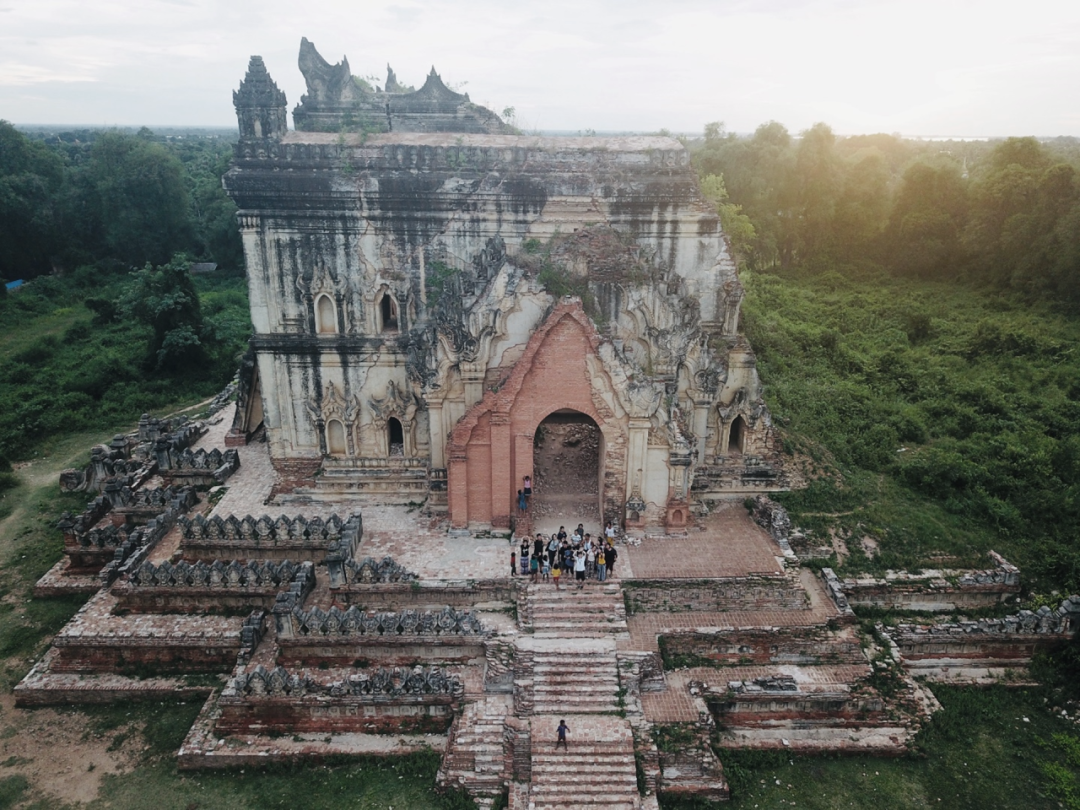
图2 雷提大佛寺震前照片 来源:东南大学2017年赴缅调研团队
Figure 2. Photo before earthquake (Source: Southeast University)

图3 雷提大佛寺震前建筑细部照片 来源:https://www.google.com/maps/contrib/107741985883876297165/reviews/@19.4335729,96.1941613,1084058m/data=!3m2!1e3!4b1!4m3!8m2!3m1!1e1?hl=zh-CN&entry=ttu&g_ep=EgoyMDI1MDQwMi4xIKXMDSoASAFQAw%3D%3D
Figure 3. Photo before earthquake

图4 雷提大佛寺震前建筑细部照片 来源:https://www.google.com/maps/contrib/107741985883876297165/reviews/@19.4335729,96.1941613,1084058m/data=!3m2!1e3!4b1!4m3!8m2!3m1!1e1?hl=zh-CN&entry=ttu&g_ep=EgoyMDI1MDQwMi4xIKXMDSoASAFQAw%3D%3D
Figure 4. Photo before earthquake
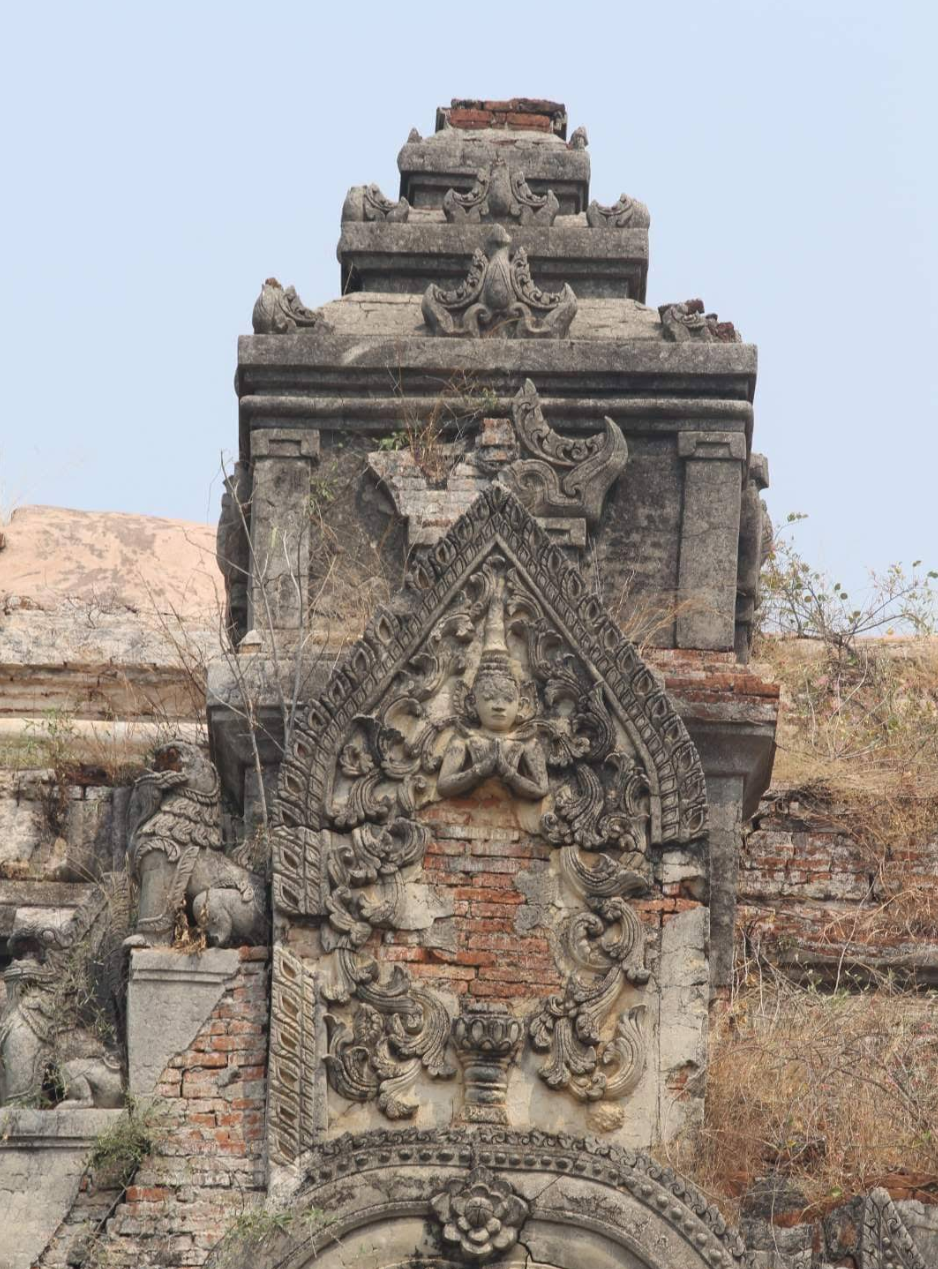
图5 雷提大佛寺震前建筑细部照片 来源:https://www.google.com/maps/contrib/107741985883876297165/reviews/@19.4335729,96.1941613,1084058m/data=!3m2!1e3!4b1!4m3!8m2!3m1!1e1?hl=zh-CN&entry=ttu&g_ep=EgoyMDI1MDQwMi4xIKXMDSoASAFQAw%3D%3D
Figure 5. Photo before earthquake
“
03 损毁情况
据缅甸社交媒体、震区群众相关消息,本次强震导致雷提大佛寺主体建筑原四层砖石主体结构彻底垮塌,仅存台基部分。现存台基以砖石混合砌筑,表面仅可见部分残存灰泥装饰残迹(如花卉浮雕局部)。
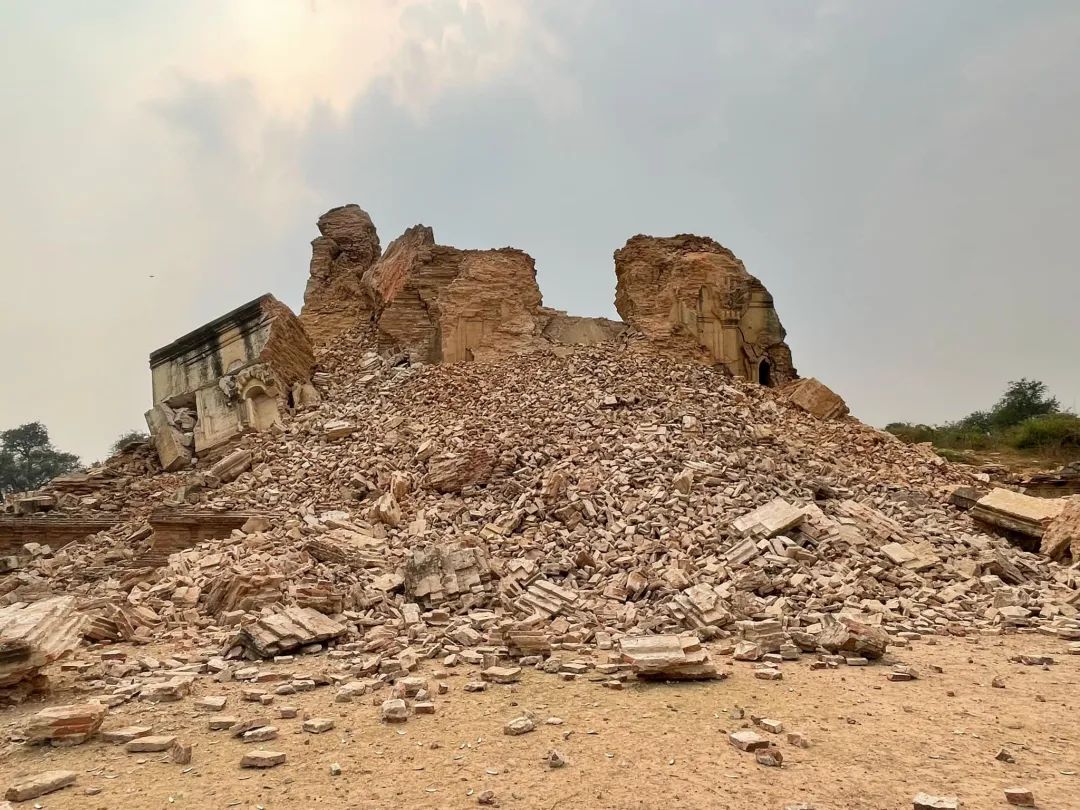
图6 雷提大佛寺震后照片 来源:缅甸当地群众
Figure 6. Photo after earthquake (Source: Photo from Local people in Myanmar)
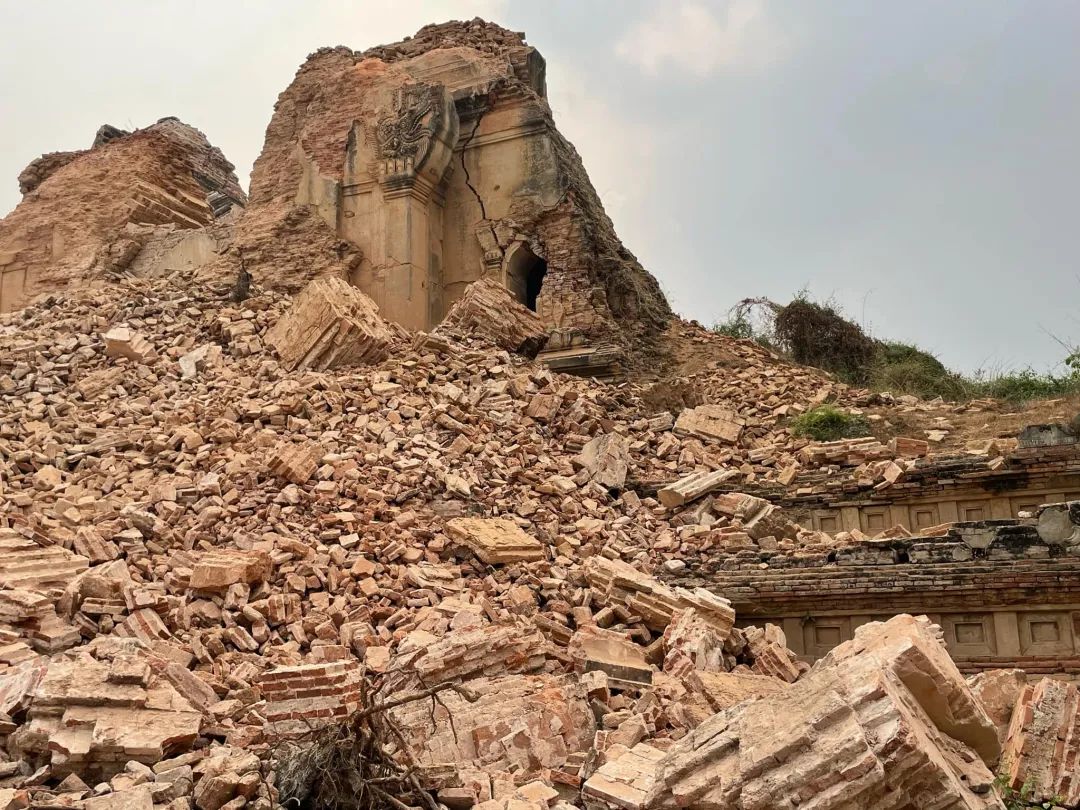
图7 雷提大佛寺震后照片 来源:缅甸当地群众
Figure 7. Photo after earthquake (Source: Photo from Local people in Myanmar)
The following is the English version:

Express News
Post-earthquake Express News on Myanmar's Historical and Cultural Heritage
Foreword
The 7.9-magnitude earthquake that struck on March 28, 2025 caused heavy losses to Myanmar. According to the latest report, as of April 8th, the strong earthquake that struck Myanmar on the 28th has resulted in 3600 deaths, with another 5017 injured and approximately 160 missing. We extend our deepest condolences to all the victims.
The earthquake also dealt a devastating blow to numerous cultural heritage sites along Mandalay - Sagaing - Naypyitaw region, with about 150 temples and pagodas damaged. Important with about 670 temples and 290 pagodas damaged. Important structures such as the King Palace, Mahamuni Pagoda, Me Nu Oak Kyaung, Innwa Bridge have suffered severe damage or been reduced to ruins. Hundreds of stupas and temples collapsed. The survival of the common cultural heritages of mankind is facing a severe test.
To this end, the Asian Academy for Heritage Management has released a series of "Post-earthquake Express News on Myanmar's Historical and Cultural Heritages", calling on the global community to pay attention to the precious value of Myanmar's historical and cultural heritages and the damages condition after the earthquake, and jointly protect the treasures of human civilization.
06
Post-earthquake Express News of Lay Htat Gyi Temple
“
01 Heritage Overview
Located in the southern part of Inwa Ancient City, Myanmar, at coordinates 21°50'24.6" N, 95°58'39.2" E, Lay Htat Gyi Temple is a significant Buddhist architectural relic from the Amarapura Era (late 16th to early 17th century). The temple features a square layout measuring 200 feet (approximately 61 meters) in length and width, with a height of 90 feet (about 27.4 meters). Originally constructed as a four-story wooden monastery, it was later reconstructed in brick and stone, preserving its distinctive multi-tiered square form. Its history dates back to 1597–1599, when it was commissioned by King Nyaung Yan (Thihathura Maha Dhamayazr) of the Second Inwa Dynasty and completed by his son, King Maha Da Ma Yarzar. The temple was destroyed by fire during the Sino-Burmese War in 1766, rebuilt in brick under the patronage of King Bagyidaw of the Konbaung Dynasty in 1835, and damaged again by an earthquake in 1838. Subsequent restoration efforts have preserved it as a testament to Myanmar’s dynastic transitions and architectural evolution.
“
02 Cultural Features
The cultural significance of Lay Htat Gyi Temple lies in its profound integration of architectural artistry and religious symbolism. As one of Myanmar’s rare square-plan, four-story Buddhist temples, its name "Lay" (meaning "four" in Burmese) directly references its original four-tiered structure. The temple’s intricate decorative details include floral stucco reliefs adorning its terraces, statues of mythical ogres (Beeloo) at its four corners, and miniature stupas at each tier’s edges, reinforcing Buddhist iconography. The floral pediments above its entrances symbolize Mount Meru, the cosmic axis in Buddhist cosmology, while stairways on all four sides embody the universal salvation ethos of Buddhism. Having endured warfare, earthquakes, and multiple reconstructions, the temple exemplifies the transition from wooden to brick-and-stone construction techniques and synthesizes Myanmar’s traditional ornamental craftsmanship with indigenous mythological elements, making it a vital resource for studying Buddhist architecture and cultural syncretism.
“
03 Damages Condition
According to recent reports from Myanmar social media and local residents in the earthquake-affected area, the recent powerful tremor caused the complete collapse of the temple’s original four-story brick and stone structure, leaving only the base platform intact. The surviving base, constructed of mixed brick and stone masonry, retains partial remnants of stucco decorations, such as fragments of floral reliefs.
END
图片来源:亚洲遗产管理学会
文字来源:亚洲遗产管理学会
学术支持:城市与建筑遗产保护教育部重点实验室(东南大学)
中国城市规划学会城市规划历史与理论分会
制作:翟广锋、May Myat Noe Ko
审核:汪艳
审定:董卫、江泓

扫码关注
亚洲遗产管理学会
Asian Academy for
Heritage Management
Express News
缅甸历史文化遗产震后速报
引言 | Foreword
2025年3月28日发生的7.9级强震致使缅甸遭遇重大损失,据中国新闻网和新京报最新通报,截至4月8日,缅甸28日发生的强震已造成3600人遇难,另有5017人受伤,约160人失踪,我们向所有遇难者致以沉痛的哀悼。地震也对缅甸曼德勒-实皆-内比都沿线众多的文化遗产造成了毁灭性打击,约670座寺庙损毁、290座佛塔倾覆,曼德勒皇宫、马哈牟尼佛寺、梅努寺、阿瓦大桥等重要建筑损毁严重或变为废墟。数百座佛塔、寺庙坍塌,人类共同文化遗产存续正面临严峻考验。
为此,亚洲遗产管理学会特发布系列“缅甸历史文化遗产震后速报”,呼吁全球社会关注缅甸历史文化遗产的珍贵价值及震后损毁情况,共同守护人类文明的瑰宝。
06
雷提大佛寺震后速报
Post-earthquake Express News of
Lay Htat Gyi Temple
“
01 遗产概况
雷提大佛寺坐落于缅甸因瓦古城南部,地理位置坐标为北纬21°50'24.6"、东经95°58'39.2",是阿玛拉普拉时期(Amarapura Era, 16世纪末至17世纪初)的重要佛教建筑遗存。寺院平面呈正方形布局,边长与高度分别达200英尺(约61米)和90英尺(约27.4米),原为四层木构建筑,后经砖石重建,保留了独特的方形多层形制。其历史可追溯至1597-1599年,由第二因瓦王朝的良渊王(Nyaung Yan)捐建,后由其子摩诃达玛亚扎王(Maha Da Ma Yarzar)续建完成。寺院在1766年中缅战争中毁于战火,1835年由贡榜王朝巴基道王(Bagyidaw)主持重建为砖石结构,次年又因地震受损,经后世修复得以保存至今,成为缅甸王朝更迭与建筑技术演变的见证者。

图1 雷提大佛寺区位示意图(来源:东南大学团队自绘)
Figure 1. Location of Lay Htat Gyi Temple (Source: Southeast University)
“
02 文化特色
雷提大佛寺的文化价值集中体现于其建筑艺术与宗教象征的深度融合。作为缅甸较少见的方形四层佛寺,其名称“Lay”(缅语“四”)呼应了原建筑的四层结构。寺院装饰细节丰富,露台饰以繁复的花卉灰泥浮雕,四角矗立缅甸神话中的食人魔像(Beeloo),每层转角处设立小型佛塔强化了佛教象征体系。四面入口的花卉三角楣饰以须弥山为意象,暗合佛教教义宇宙观,四面通达的阶梯设计隐喻佛法普度众生的开放精神。寺院历经战火、地震与多次重建后,展现了木构向砖石结构的技艺革新,也凝聚了缅甸传统纹样工艺与本土神话元素,成为研究佛教建筑史与王朝文化交融的珍贵载体。

图2 雷提大佛寺震前照片 来源:东南大学2017年赴缅调研团队
Figure 2. Photo before earthquake (Source: Southeast University)

图3 雷提大佛寺震前建筑细部照片 来源:https://www.google.com/maps/contrib/107741985883876297165/reviews/@19.4335729,96.1941613,1084058m/data=!3m2!1e3!4b1!4m3!8m2!3m1!1e1?hl=zh-CN&entry=ttu&g_ep=EgoyMDI1MDQwMi4xIKXMDSoASAFQAw%3D%3D
Figure 3. Photo before earthquake

图4 雷提大佛寺震前建筑细部照片 来源:https://www.google.com/maps/contrib/107741985883876297165/reviews/@19.4335729,96.1941613,1084058m/data=!3m2!1e3!4b1!4m3!8m2!3m1!1e1?hl=zh-CN&entry=ttu&g_ep=EgoyMDI1MDQwMi4xIKXMDSoASAFQAw%3D%3D
Figure 4. Photo before earthquake

图5 雷提大佛寺震前建筑细部照片 来源:https://www.google.com/maps/contrib/107741985883876297165/reviews/@19.4335729,96.1941613,1084058m/data=!3m2!1e3!4b1!4m3!8m2!3m1!1e1?hl=zh-CN&entry=ttu&g_ep=EgoyMDI1MDQwMi4xIKXMDSoASAFQAw%3D%3D
Figure 5. Photo before earthquake
“
03 损毁情况
据缅甸社交媒体、震区群众相关消息,本次强震导致雷提大佛寺主体建筑原四层砖石主体结构彻底垮塌,仅存台基部分。现存台基以砖石混合砌筑,表面仅可见部分残存灰泥装饰残迹(如花卉浮雕局部)。

图6 雷提大佛寺震后照片 来源:缅甸当地群众
Figure 6. Photo after earthquake (Source: Photo from Local people in Myanmar)

图7 雷提大佛寺震后照片 来源:缅甸当地群众
Figure 7. Photo after earthquake (Source: Photo from Local people in Myanmar)
The following is the English version:

Express News
Post-earthquake Express News on Myanmar's Historical and Cultural Heritage
Foreword
The 7.9-magnitude earthquake that struck on March 28, 2025 caused heavy losses to Myanmar. According to the latest report, as of April 8th, the strong earthquake that struck Myanmar on the 28th has resulted in 3600 deaths, with another 5017 injured and approximately 160 missing. We extend our deepest condolences to all the victims.
The earthquake also dealt a devastating blow to numerous cultural heritage sites along Mandalay - Sagaing - Naypyitaw region, with about 150 temples and pagodas damaged. Important with about 670 temples and 290 pagodas damaged. Important structures such as the King Palace, Mahamuni Pagoda, Me Nu Oak Kyaung, Innwa Bridge have suffered severe damage or been reduced to ruins. Hundreds of stupas and temples collapsed. The survival of the common cultural heritages of mankind is facing a severe test.
To this end, the Asian Academy for Heritage Management has released a series of "Post-earthquake Express News on Myanmar's Historical and Cultural Heritages", calling on the global community to pay attention to the precious value of Myanmar's historical and cultural heritages and the damages condition after the earthquake, and jointly protect the treasures of human civilization.
06
Post-earthquake Express News of Lay Htat Gyi Temple
“
01 Heritage Overview
Located in the southern part of Inwa Ancient City, Myanmar, at coordinates 21°50'24.6" N, 95°58'39.2" E, Lay Htat Gyi Temple is a significant Buddhist architectural relic from the Amarapura Era (late 16th to early 17th century). The temple features a square layout measuring 200 feet (approximately 61 meters) in length and width, with a height of 90 feet (about 27.4 meters). Originally constructed as a four-story wooden monastery, it was later reconstructed in brick and stone, preserving its distinctive multi-tiered square form. Its history dates back to 1597–1599, when it was commissioned by King Nyaung Yan (Thihathura Maha Dhamayazr) of the Second Inwa Dynasty and completed by his son, King Maha Da Ma Yarzar. The temple was destroyed by fire during the Sino-Burmese War in 1766, rebuilt in brick under the patronage of King Bagyidaw of the Konbaung Dynasty in 1835, and damaged again by an earthquake in 1838. Subsequent restoration efforts have preserved it as a testament to Myanmar’s dynastic transitions and architectural evolution.
“
02 Cultural Features
The cultural significance of Lay Htat Gyi Temple lies in its profound integration of architectural artistry and religious symbolism. As one of Myanmar’s rare square-plan, four-story Buddhist temples, its name "Lay" (meaning "four" in Burmese) directly references its original four-tiered structure. The temple’s intricate decorative details include floral stucco reliefs adorning its terraces, statues of mythical ogres (Beeloo) at its four corners, and miniature stupas at each tier’s edges, reinforcing Buddhist iconography. The floral pediments above its entrances symbolize Mount Meru, the cosmic axis in Buddhist cosmology, while stairways on all four sides embody the universal salvation ethos of Buddhism. Having endured warfare, earthquakes, and multiple reconstructions, the temple exemplifies the transition from wooden to brick-and-stone construction techniques and synthesizes Myanmar’s traditional ornamental craftsmanship with indigenous mythological elements, making it a vital resource for studying Buddhist architecture and cultural syncretism.
“
03 Damages Condition
According to recent reports from Myanmar social media and local residents in the earthquake-affected area, the recent powerful tremor caused the complete collapse of the temple’s original four-story brick and stone structure, leaving only the base platform intact. The surviving base, constructed of mixed brick and stone masonry, retains partial remnants of stucco decorations, such as fragments of floral reliefs.
END
图片来源:亚洲遗产管理学会
文字来源:亚洲遗产管理学会
学术支持:城市与建筑遗产保护教育部重点实验室(东南大学)
中国城市规划学会城市规划历史与理论分会
制作:翟广锋、May Myat Noe Ko
审核:汪艳
审定:董卫、江泓

扫码关注
亚洲遗产管理学会
Asian Academy for
Heritage Management
